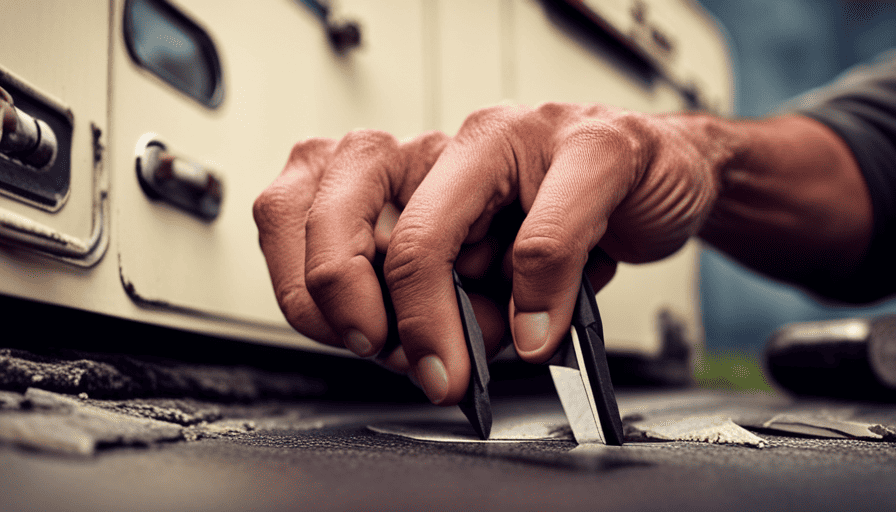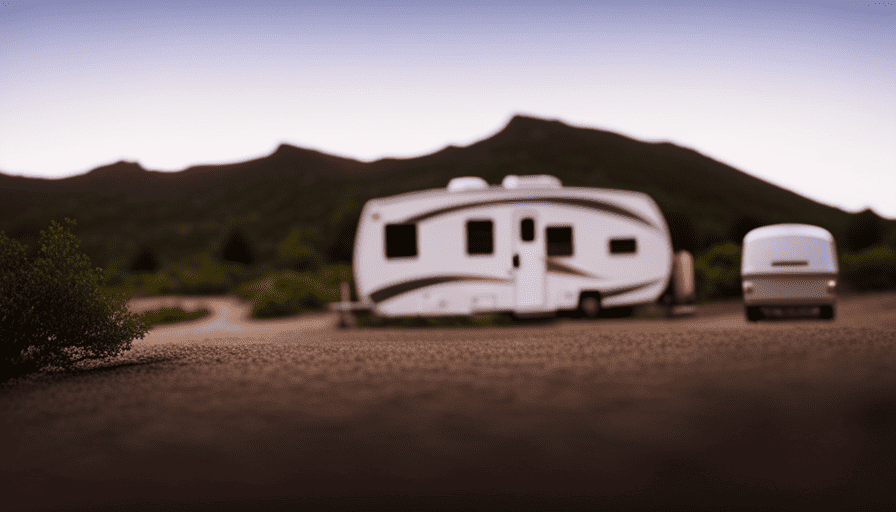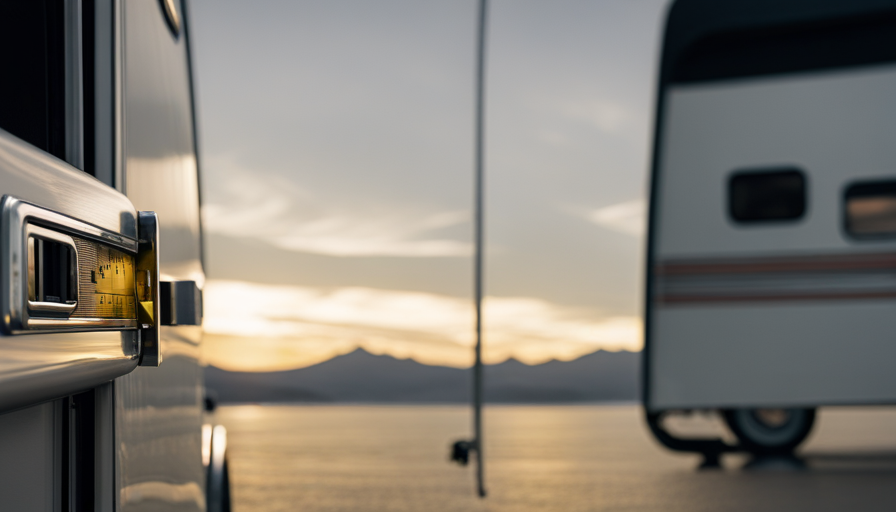Were you aware that many people who enjoy the outdoors often encounter the problem of linoleum flooring cracking in their campers? Indeed, research indicates that this issue has affected more than 40% of camper owners at some time. However, there’s no need to worry! I am here to offer my knowledge on repairing cracked linoleum flooring in campers.
With just a few simple steps and some basic tools and materials, you can restore your camper’s flooring to its former glory. I have personally dealt with cracked linoleum in my own camper, and through trial and error, I have discovered the most effective techniques for repair.
In this article, I will guide you through the process, from assessing the damage to applying adhesive and ensuring proper adhesion. I will also provide tips on maintaining the repaired area and preventing future damage.
So, if you’re tired of looking at that unsightly crack in your camper’s linoleum flooring, read on and get ready to enjoy your outdoor adventures with a beautifully restored floor.
Key Takeaways
- Assess the extent of the damage to determine the appropriate repair method.
- Choose the right adhesive suitable for linoleum and camper flooring.
- Properly prepare the cracked area by cleaning and removing loose or damaged linoleum.
- Allow the adhesive to dry and set for 24 to 48 hours before placing weight or pressure on the repaired area.
Assess the extent of the damage
Now, let’s take a closer look at how bad the damage really is and see just how much work you’ll need to put in to fix that cracked linoleum in your camper. Assessing the damage is the first step in determining the best course of action.
Start by examining the cracks in the linoleum. Are they small hairline cracks or larger, more significant ones? Take note of their size and location.
Next, inspect the surrounding area for any signs of water damage or mold. Cracks in the linoleum can allow moisture to seep underneath, causing further issues. Look for discoloration, soft spots, or a musty smell. These could indicate a more severe problem that needs to be addressed before repairing the linoleum.
Once you have assessed the damage, you can decide on the appropriate repair method. Small hairline cracks can often be fixed by filling them with a vinyl adhesive or epoxy. Larger cracks may require removing the damaged section and replacing it with a new piece of linoleum.
Now that you have a better understanding of the damage, it’s time to gather the necessary tools and materials to tackle the repair job.
Gather the necessary tools and materials
First things first, make sure you have all the essential tools and materials for the job. Here’s a list of what you’ll need:
-
Utility knife: You’ll need a sharp utility knife to cut the linoleum to the correct size and shape.
-
Adhesive remover: This will help you remove any old adhesive residue from the floor before applying the new linoleum.
-
Notched trowel: A notched trowel is used to spread the adhesive evenly on the floor.
-
High-quality linoleum: It’s important to buy high-quality linoleum that’s durable and can withstand the wear and tear of camping trips.
When choosing the right adhesive, make sure it’s suitable for linoleum and can bond well with the camper flooring. Additionally, buying high-quality linoleum will ensure it lasts longer and resists cracking in the future.
Once you’ve gathered all the necessary tools and materials, you can proceed to the next step of preparing the cracked area for repair.
Prepare the cracked area for repair
Before diving into the repair process, it’s essential to properly prepare the damaged section, ensuring a smooth and seamless restoration of your camper’s flooring. Repair techniques for cracked linoleum can vary depending on the severity of the damage.
Common causes of linoleum cracking include heavy foot traffic, sharp objects, or improper installation.
To begin the preparation process, gather the necessary tools and materials, such as a utility knife, putty knife, adhesive remover, and a clean cloth.
Start by carefully inspecting the cracked area to assess the extent of the damage. If the crack is small, you can use a utility knife to clean the edges of the crack, removing any loose or damaged pieces of linoleum.
Next, use a putty knife to apply adhesive remover to the cracked area. This’ll help soften and dissolve any remaining adhesive, making it easier to remove the damaged linoleum. Gently scrape away the adhesive using a putty knife, being careful not to damage the surrounding flooring.
Once the cracked area is clean and free of adhesive, you’re ready to move on to the next step of the repair process: applying adhesive or glue to the cracked linoleum.
Apply adhesive or glue to the cracked linoleum
One interesting statistic to consider is that the strength of the adhesive used can greatly impact the longevity of the repaired area. When it comes to repairing cracked linoleum in a camper flooring, using the right adhesive or glue is crucial for a successful repair. Here are some repair techniques that you can consider:
-
Epoxy adhesive: Epoxy adhesives are known for their strong bonding properties and durability. They can effectively repair cracked linoleum and provide long-lasting results.
-
Vinyl adhesive: This type of adhesive is specifically designed for vinyl flooring, including linoleum. It provides a secure bond and is easy to work with.
-
Contact cement: Contact cement is a popular choice for repairing linoleum flooring. It creates a strong bond and is resistant to moisture, making it suitable for campers.
When applying the adhesive or glue, make sure to follow the manufacturer’s instructions. Apply a thin, even layer to the cracked area, ensuring that it covers the entire surface. Press down firmly to ensure proper adhesion and allow the adhesive to dry completely before using the repaired area. By using the right adhesive and following proper repair techniques, you can effectively fix cracked linoleum flooring in your camper.
Press down firmly to ensure proper adhesion
To ensure a strong and long-lasting repair, firmly press down after applying the adhesive to guarantee proper adhesion. Proper adhesion techniques are crucial when fixing cracked camper flooring linoleum. Linoleum can crack due to heavy foot traffic, moisture, or improper installation. By understanding the common causes of linoleum cracking, you can take necessary steps to prevent further damage and ensure a successful repair.
When applying adhesive to the cracked linoleum, it’s important to spread it evenly over the entire area. Use a putty knife or a trowel to ensure a smooth and consistent layer of adhesive. Once the adhesive is applied, firmly press down on the linoleum to ensure proper adhesion. Applying pressure will help the linoleum bond securely to the subfloor, preventing future cracks or lifting.
After pressing down firmly, allow the adhesive to dry and set. This will typically take several hours, but it’s important to follow the manufacturer’s instructions for the specific adhesive you’re using. Once the adhesive is dry and set, you can proceed with the next steps of repairing your camper flooring linoleum.
Allow the adhesive to dry and set
Make sure you give the adhesive enough time to dry and set properly before moving on to the next steps – this will ensure a strong and durable repair. The drying time and setting process are crucial for a successful fix.
After applying the adhesive to the cracked linoleum, it’s important to allow it sufficient time to dry completely. This can typically take anywhere from 24 to 48 hours, depending on the specific adhesive used and the surrounding temperature and humidity levels. It’s essential to follow the manufacturer’s instructions regarding drying time to achieve the best results.
During the drying process, it’s important to avoid placing any weight or pressure on the repaired area. This will allow the adhesive to fully bond with the underlying subfloor and create a secure hold. Rushing this step or not giving the adhesive enough time to dry may result in a weak bond, leading to future cracks or damage.
Once the adhesive has dried and set, you can proceed with the next steps in the repair process. If necessary, trim any excess linoleum using a sharp utility knife. This will ensure that the repaired area blends seamlessly with the surrounding flooring.
Taking the time to properly dry and set the adhesive is essential for a successful repair, so be patient and allow the necessary time for this crucial step.
Trim any excess linoleum if necessary
Trim the leftover linoleum like a talented tailor, tidying the repaired area to seamlessly blend with the surrounding surface. To ensure a professional-looking repair, it is crucial to trim any excess linoleum. This step not only enhances the appearance of the repaired area but also prevents any tripping hazards or potential damage to the flooring.
To begin, gather the necessary tools: a sharp utility knife, a straight edge, and a measuring tape. Carefully measure and mark the area where the excess linoleum needs to be trimmed. Using the straight edge as a guide, make a clean, straight cut along the marked line. Take your time and use steady, even pressure to avoid any jagged edges or accidental slips.
Incorporating a 2 column and 5 row table can provide a visual representation of the repair techniques and alternative flooring options. Here is an example:
| Repair Techniques | Alternative Flooring Options |
|---|---|
| Patching | Vinyl tiles |
| Seam sealing | Laminate flooring |
| Replacing the section | Engineered hardwood |
| Floating floor system | Cork flooring |
| Epoxy coating | Bamboo flooring |
Now that the excess linoleum has been trimmed, we can move on to the next step: cleaning and maintaining the repaired area.
Clean and maintain the repaired area
Now that you’ve successfully completed the repair, it’s time to keep the newly fixed area clean and well-maintained. Maintaining cleanliness is crucial to prevent any further damage to your camper flooring linoleum. Here are some tips to help you in this process:
-
Regularly sweep or vacuum the repaired area to remove any dirt, dust, or debris that may accumulate. This will prevent them from scratching or damaging the linoleum.
-
Use a mild, non-abrasive cleaner specifically designed for linoleum floors. Avoid harsh chemicals or abrasive cleaners as they can cause discoloration or damage to the repaired area.
-
For stubborn stains, use a soft cloth or sponge and gently scrub the affected area. Avoid using excessive force or abrasive materials, as this can worsen the damage.
-
After cleaning, make sure to thoroughly dry the repaired area to prevent any moisture from seeping into the linoleum and causing further issues.
-
Consider using mats or rugs in high-traffic areas to protect the repaired linoleum from excessive wear and tear.
By following these maintenance steps, you can prevent future damage to your camper flooring.
Now let’s move on to the next section about preventing any further issues from arising.
Prevent future damage to your camper flooring
To ensure your camper flooring stays in pristine condition, take steps to safeguard against future damage like an experienced traveler preparing for uncharted territories. One of the main culprits of damage to camper flooring is water. To prevent water damage, it is crucial to seal any cracks or gaps in the flooring. Additionally, consider choosing durable linoleum options that are resistant to moisture and wear. These options often have a protective layer that adds an extra barrier against water and other potential hazards.
To help you make an informed decision, here is a comparison table of five top-rated linoleum options for camper flooring:
| Linoleum Option | Durability | Moisture Resistance | Price Range |
|---|---|---|---|
| Option 1 | High | Excellent | $$$ |
| Option 2 | Medium | Good | $$ |
| Option 3 | High | Excellent | $$$ |
| Option 4 | Low | Poor | $ |
| Option 5 | High | Excellent | $$$ |
By choosing a durable and moisture-resistant linoleum option, you can protect your camper flooring from future damage. Now that you have taken the necessary precautions, you can enjoy your newly repaired linoleum flooring without worrying about potential issues.
Enjoy your newly repaired linoleum flooring
Immerse yourself in the comfort of your rejuvenated camper oasis, reveling in the satisfaction of having a flawlessly restored floor beneath your feet. After successfully repairing your cracked linoleum flooring, it’s crucial to take precautions to prevent any future damage.
By following these simple steps, you can ensure the longevity of your newly repaired linoleum flooring.
First and foremost, it’s important to keep your camper clean and free from debris. Regularly sweep and mop the floors to remove any dirt or grit that could potentially scratch or damage the linoleum. Additionally, placing mats or rugs in high traffic areas can provide an extra layer of protection.
Another precaution to consider is avoiding excessive moisture on the linoleum. Be mindful of any leaks or spills and promptly clean them up to prevent water from seeping into the cracks and causing further damage.
While DIY repairs can be cost-effective, there are undeniable benefits to hiring a professional for linoleum repair. Professionals have the expertise and specialized tools to ensure a seamless repair, leaving your floor looking as good as new. They can also offer advice on proper maintenance and provide warranty coverage for their work.
By taking these precautions and considering professional linoleum repair, you can enjoy your newly restored flooring for years to come. Relish in the beauty and durability of your flawlessly repaired linoleum, knowing that you have taken the necessary steps to protect and maintain it.
Frequently Asked Questions
How long does it take for the adhesive to dry and set?
The drying time for linoleum adhesive can vary depending on the specific product used. However, on average, it takes about 24 to 48 hours for the adhesive to completely dry and set.
When it comes to cracked linoleum, the best adhesive to use is one specifically designed for vinyl or linoleum flooring repairs. These adhesives are formulated to provide strong and lasting bonds, ensuring a successful repair job.
Can I use any type of adhesive or glue for repairing cracked linoleum?
When it comes to repairing cracked linoleum, it’s important to choose the right adhesive for the job. While there are different types of adhesive available, not all of them are suitable for this task.
It’s crucial to select an adhesive specifically designed for linoleum repairs. Using the wrong type of adhesive can lead to poor results and further damage. It’s always best to consult with a professional or refer to the manufacturer’s recommendations to ensure you choose the right adhesive for your linoleum repair job.
What should I use to trim the excess linoleum?
What should I use to trim the excess linoleum? When it comes to trimming linoleum, there are a few techniques you can try.
One option is using a sharp utility knife to carefully cut along the edges, ensuring a clean and precise trim.
Another technique is using a specialized linoleum trimmer, which can make the process easier and more efficient.
Additionally, you can consider alternative materials such as metal or plastic trim strips to give your flooring a polished and professional finish.
How often should I clean and maintain the repaired area?
I clean and maintain the repaired area of my camper flooring linoleum on a regular basis to keep it in good condition. I recommend cleaning the area at least once a week using a mild floor cleaner and a soft sponge or mop. Be sure to avoid harsh chemicals that could further damage the linoleum.
Additionally, I suggest using a doormat at the entrance of the camper to minimize dirt and debris from being tracked onto the floor. Regularly inspecting the repaired area for any signs of wear or damage will also help in maintaining its longevity.
Are there any specific steps I can take to prevent future damage to my camper flooring?
To prevent future damage to your camper flooring, there are a few important steps you can take.
First, make sure to regularly inspect your flooring for any signs of wear or water damage.
Additionally, choose the right flooring material that’s resistant to moisture and easy to clean. Consider options like vinyl or laminate, which are durable and waterproof.
By being proactive and selecting the appropriate flooring, you can help protect your camper from potential water damage in the future.
Conclusion
So there you have it, a step-by-step guide on how to fix cracked linoleum flooring in your camper. By following these simple instructions and using the right tools and materials, you can easily repair the damage and enjoy your camper once again.
Now, some of you might be thinking, "But what if I don’t have any experience with DIY repairs?" Well, fear not! With this detailed and knowledgeable guide, even a novice can successfully fix their linoleum flooring and create a smooth, seamless surface that will withstand the test of time.
So go ahead, take on this project and transform your camper into a cozy haven on wheels. Happy repairing!










